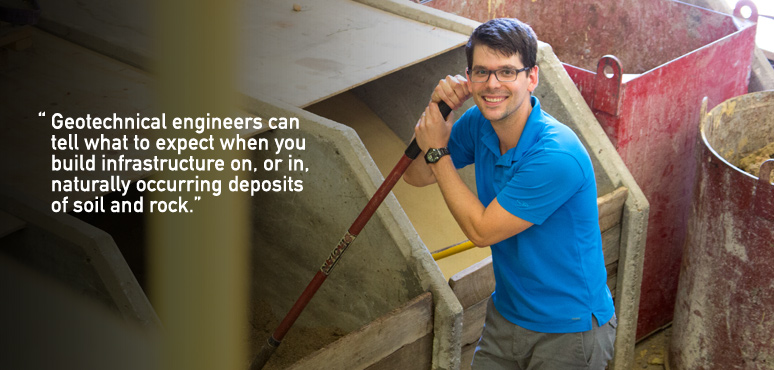Researcher Highlights
Hitting the ground running
Dr James Hambleton
Giving roughly equal weight to experimental and theoretical aspects of geomechanics, Dr Jim Hambleton is digging deep to amplify knowledge about the natural world.

Dr Jim Hambleton is a self-described "dirt man." Sunnily asserting his intrigue and the importance of some of our planet's most mundane materials – earth and stone - the early career researcher boasts it's a challenging but "very fascinating" professional setting he finds himself in.
"I started out wanting to be a structural engineer because working with major buildings sounded really cool," he laughs.
"By the end of my undergraduate degree, however, I was convinced geomechanics was the way to go."
"Soil and rocks are much more puzzling."
"We still don't know how they behave – composites like steel and concrete are created by us to act a certain way."
Faithful to these origins, Jim studies elements of both natural and manmade environments. Whether the application is construction or mining, tribology, or even terrestrial exploration, the North American native avows it's essential to understand our effects as geomorphic agents.
"It turns out, probably unsurprisingly, that human beings move an enormous amount of earth each year," he explains.
"We continue to do so without really acknowledging or grasping what it is we're actually doing."
"Fully understanding these processes poses a tremendous challenge, particularly when you consider the confluence of potentially three-dimensional deformation, contact interaction, material instabilities and rate effects."
Best known for his expertise in computational plasticity, Jim is also well versed in modelling problems in geo and solid mechanics.
"When you put bridges and roads on the Earth you need to know how much they will penetrate under loading, even under their own self weight, and how much they are going to settle over time," he clarifies.
"More dramatically, you have to make sure that they're not going to fail, which we see quite often unfortunately with landslides, tunnel collapses and sink holes."
Tackling grit with grit
Jim's experience in dealing with these complications can be traced back to his PhD thesis. An ambitious postgraduate student at the University of Minnesota in the United States, he looked to examine soil-wheel interactions between 2007 and 2010.
"There are all kinds of reasons why you would be interested in this," the International Association of Computational Mechanics member suggests.
"It encompasses mobility difficulties, for example, whether they are off-road machinery here on Earth or rovers on Martian landscapes."
"Getting unstuck is a really tricky problem!"
"My doctoral work has ramifications for several environmental issues too – the destruction of vegetation, changes in runoff, and erosion all start with wheels damaging the soil."
Seeking to put science behind some "very empirical" data, Jim set about developing rigorous modelling framework for this specialist research area. Morphing into "something quite fundamental," the impressive innovator's three-year probe duly served to document the process by which plastic deformation is induced in different terrains.
"It produced a handful of offshoots," he recalls.
"I conducted subsequent studies on wheels themselves, for example."
Down to earth
Jim relocated to Australia after receiving his PhD, signing on to become a postdoctoral research associate with the University of Newcastle's Centre for Geotechnical and Materials Modelling. Teaming up with academics from the University of Western Australia and University of Wollongong a year later, the passionate scholar switched over to the Australian Research Council's Centre of Excellence for Geotechnical Science and Engineering.
"It was an absolute blessing," he states.
"It's brought together a really wonderful, smart group of people."
Continuing to collaborate with some of the field's boldest and brightest, Jim is currently investigating the mechanics of installation for screw piles and screw-type devices.
"The former are deep foundations that consist of one or more helical plates mounted to a central shaft," he comments.
"They're installed by twisting the pile into the ground under an applied torque or axial force."
"The latter, on the other hand, are encountered in a large number of applications, ranging from the fasteners used in building construction to the biomedical screws used to secure bone and other tissue."
With "relatively few attempts" made to model these processes theoretically, Jim is looking to champion multidisciplinary research about the fundamentals of ground anchoring systems.
"We're in a period of infancy in terms of understanding how they actually work," he admits.
"They're easy to install, but, depending on the load combination, can under-rotate, neutrally rotate, or over-rotate, which in turn affects the amount of soil disturbance."
Dusting off some solutions
When asked about his long-term aspirations, Jim is quick to reply.
"In figuring out how soils and rocks fail under loading, a big issue is understanding the basic parameters that govern deformability and strength," he says.
"How can you measure those things effectively and speedily?"
Taking samples and "squeezing and manipulating" them in laboratory settings, Jim is eager to answer just that.
"These tests are not without their limitations though," he affirms.
"It might be better to carry out measurements in situ with a probing instrument or two."
"The science will be getting an index of actual material properties."
"Geotechnical engineers can then tell what to expect when you build infrastructure on, or in, naturally occurring deposits of soil and rock."
The University of Newcastle acknowledges the traditional custodians of the lands within our footprint areas: Awabakal, Darkinjung, Biripai, Worimi, Wonnarua, and Eora Nations. We also pay respect to the wisdom of our Elders past and present.